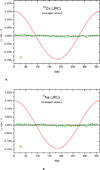Evidence against solar influence on nuclear decay constants
- PMID: 28057978
- PMCID: PMC5207040
- DOI: 10.1016/j.physletb.2016.08.038
Evidence against solar influence on nuclear decay constants
Abstract
The hypothesis that proximity to the Sun causes variation of decay constants at permille level has been tested and disproved. Repeated activity measurements of mono-radionuclide sources were performed over periods from 200 days up to four decades at 14 laboratories across the globe. Residuals from the exponential nuclear decay curves were inspected for annual oscillations. Systematic deviations from a purely exponential decay curve differ from one data set to another and are attributable to instabilities in the instrumentation and measurement conditions. The most stable activity measurements of alpha, beta-minus, electron capture, and beta-plus decaying sources set an upper limit of 0.0006% to 0.008% to the amplitude of annual oscillations in the decay rate. Oscillations in phase with Earth's orbital distance to the Sun could not be observed within a 10-6 to 10-5 range of precision. There are also no apparent modulations over periods of weeks or months. Consequently, there is no indication of a natural impediment against sub-permille accuracy in half-life determinations, renormalisation of activity to a distant reference date, application of nuclear dating for archaeology, geo- and cosmochronology, nor in establishing the SI unit becquerel and seeking international equivalence of activity standards.
Keywords: Decay constant; Half-life; Neutrino; Radioactivity; Sun; Uncertainty.
Figures



References
-
- Rutherford E. A radio-active substance emitted from thorium compounds. Philos. Mag. Ser. 1900;5 49(296):1–14.
-
- Curie M, Kamerling Onnes H. Sur le rayonnement du radium à la température de l’hydrogène liquide. Radium. 1913;10(6):181–186. (English version: The radiation of Radium at the temperature of liquid hydrogen. KNAW Proceedings 15 II, 1912–1913, Amsterdam, (1913) 1430–1441)
-
- Emery GT. Perturbation of nuclear decay rates. Annu. Rev. Nucl. Sci. 1972;22:165–202.
-
- Hahn H-P, Born H-J, Kim J. Survey on the rate perturbation of nuclear decay. Radiochim. Acta. 1976;23:23–37.
-
- Greenland PT. Seeking non-exponential decay. Nature. 1988;335:298.
Publication types
Grants and funding
LinkOut - more resources
Full Text Sources
Other Literature Sources
